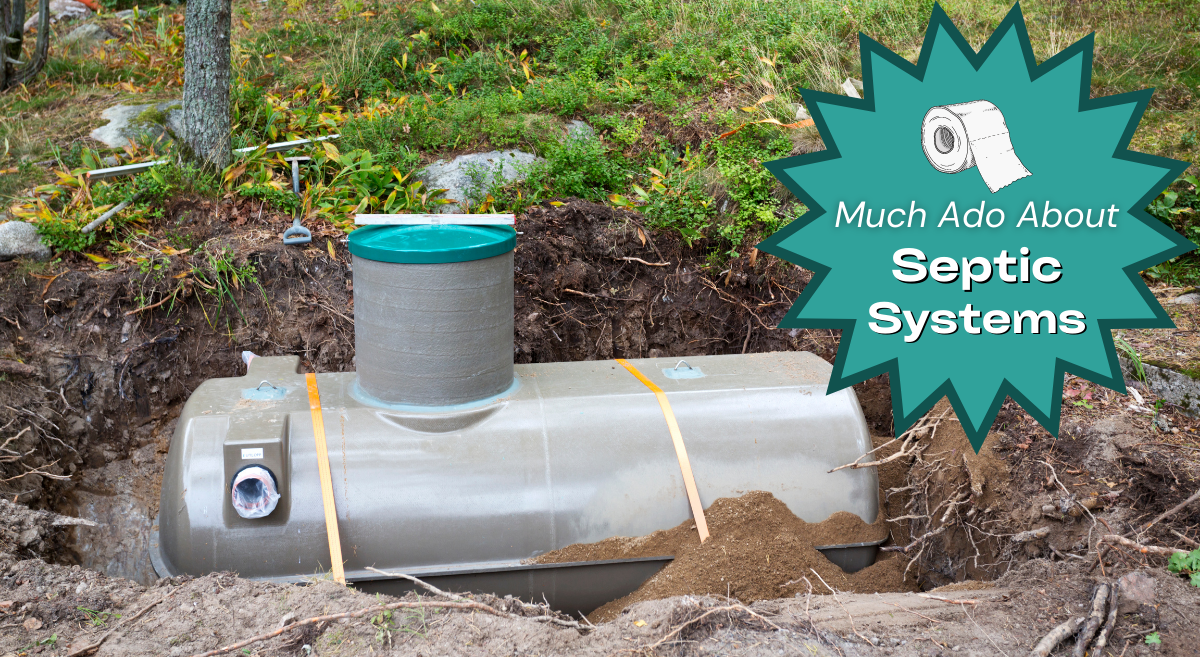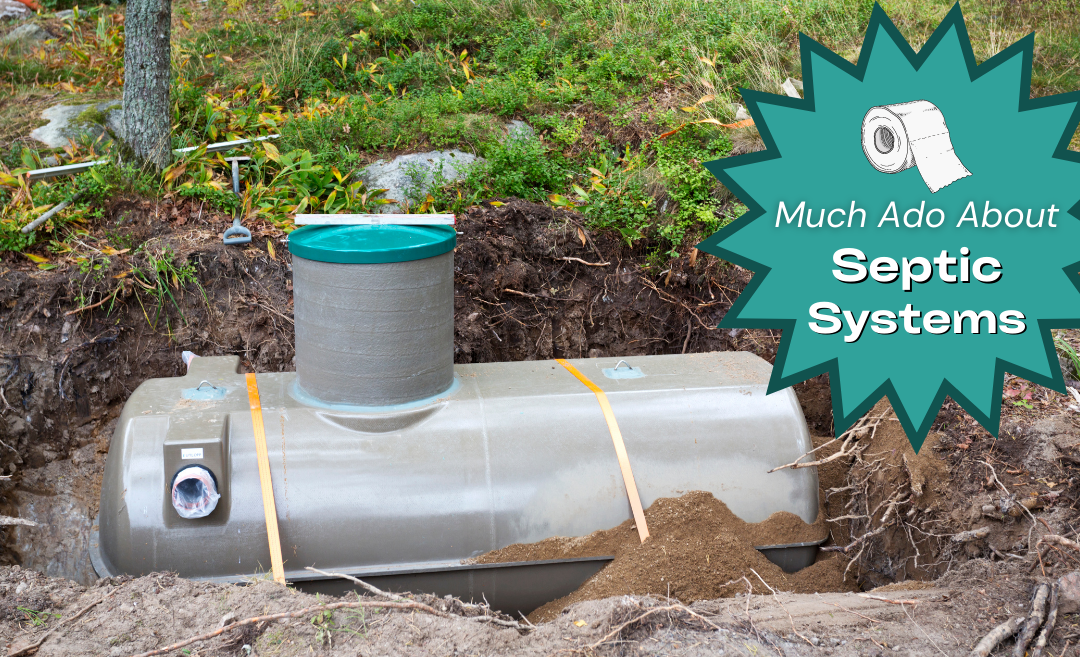Septic System Facts & Tips

Here at MountainTrue, we’re all about taking practical steps to improve water quality and lower your environmental footprint at home. If you don’t live in close proximity to a city or town, chances are high that you have a septic system. Onsite septic systems treat wastewater on residential lots and usually include a concrete tank and a drain field.
When used correctly, septic systems have many benefits. Proper use reduces the risk of diseases and exposure to harmful pathogens by treating wastewater before it reaches surface drinking water sources or waters used for recreation. Decentralized waste systems also lower the infrastructure and energy costs communities would otherwise put towards collecting and treating wastewater.
How Septic Systems Work
Septic systems treat the wastewater going through your drains and slowly release wastewater into a drainage field to neutralize pathogens, pollutants, and other contaminants before the water transitions back into the natural water cycle. A typical system separates the solids and oils — the sludge — from the rest of the liquid waste — the effluent — which then exits the tank into the drain field through perforated pipes surrounded by gravel. The water percolates, filters, and purifies as it continues going down through the drainage field soil. Here’s a visual representation of a septic system in action.
Septic System Problems
Problems with septic systems usually arise as systems age or when maintenance is neglected. Septic tanks should be inspected and pumped every three to five years, depending on the household size. Because the sludge remains in the tank, it needs to be removed before it fills the tank and causes septic system failure. System failures can lead to costly repairs, hazardous waste overflows, and excess nutrients (such as nitrogen and phosphorus) infiltrating groundwater sources. If improperly treated sewage leaches into nearby drinking waters, it can cause severe illness to those who come in contact with the water.
Other potential issues can arise when improper waste products, such as harmful chemicals and grease/fats, are disposed of down the drain. Harmful chemicals can kill helpful bacteria and other organisms that break down the wastewater, and grease/fats can lead to clogged drains or pipes. Additionally, disposing of bulky food waste and slow decomposing materials down your drains can drastically increase the amount of waste buildup in your septic tank.
Microplastic dispersion into the environment is a little-known problem in which septic systems play a prominent role. Microplastics — pieces of plastic that continuously break down into smaller pieces over time — are usually too small to be filtered by gravel and sand. As a result, microplastics and their chemical additives often leach into surface water and groundwater.
While plastic waste and litter contribute to microplastic pollution, many folks are unaware that personal care items and laundry can also be a source of microplastic pollution. Clothing items made of polyester, nylon, rayon, or spandex shed microfibers when washed. And even though microbeads were banned from rinse-off cosmetics in 2015, they are still allowed to be used in makeup, deodorants, and lotions. Individual consumers can mitigate household microplastic pollution by:
- Wearing clothes made from natural fibers and reducing consumption of clothing made from synthetic materials, when possible.
- Installing a microfiber filter on the household washing machine.
- Washing clothing made from synthetic materials in laundry bags and/or throwing microplastic collection balls into laundry loads.
- Doing laundry less often with fuller loads.
How To Locate Your Septic Tank and Drain field
It’s important that you can identify the location of your septic tank on your property. The easiest way to find your septic tank is to obtain a copy of your septic system permit from the local health department. A septic system permit will indicate the approximate location of your tank, drain field, and potentially a secondary drainage area (only found if your home was built after the 1980s).
You can also locate your tank by following the pipes that extend from your home into your yard. First, you’ll need to locate the main sewer outlet pipe, which is usually four inches in diameter and typically found in the basement or crawl space. Note where the pipe exits the house and go outside to the same location. Using a thin metal stake, probe every two feet or so, following the pipeline underground as closely as possible. Septic tanks are normally located 10-25 feet away from the house and are no closer than three feet. As soon as your probe strikes a flat concrete, fiberglass, or polyethylene surface, you’ll know you’ve found your tank.
A septic tank’s lid may be visible above ground in most newer housing developments. If the septic tank lid is underground (common for older homes), you may be able to locate it by using a metal detector. Another alternative is to use a flushable transmitter — once flushed, it can be tracked to the inlet area of the septic tank.
Action Steps For a Safe and Effective Septic System
Here are nine important practices to consider when maintaining your own septic system:
- Do not overload your system with water. Conserve water by avoiding excessive use and fixing leaky pipes and dripping faucets.
- Have solids pumped from your septic tank every three to five years. Maintenance schedules will depend on the tank size and the number of users.
- Keep the soil over the drain field covered with grass or other shallow-rooted plants to prevent erosion. Deep roots can clog systems. Maintain a healthy stand of grass to prevent erosion and excessive infiltration of water or ponding.
- Do not drive on or otherwise compact the soil above the drain field.
- Flush only toilet tissue and human waste down the toilet. Septic systems are not designed to treat pet waste.
- Do not use toilet cleaners that hang in the tank, as they can corrode your toilet’s inner workings.
- When possible, refrain from using your garbage disposal. Do not dump coffee grounds, grease, oils, or fats down your drains.
- Do not use harsh household cleaners or put other toxic chemicals like bleach, paint, solvents, or pesticides down the drain.
- Learn the signs of a malfunctioning or failing system. Backed-up water in drains or toilets, abnormally green vegetation, soggy areas over the drain field, and a foul smell could all indicate system failure.
Septic systems are excellent residential waste treatment options if they are properly maintained. Learn more by checking out the EPA’s SepticSmart program, and stay tuned for our upcoming MountainTrue University session!
Is your septic system in need of some TLC? MountainTrue has partnered with the North Carolina Department of Health and Human Services to provide septic repair funds to qualifying property owners in Buncombe, Cherokee, and Henderson counties! Click here to learn more and apply.

